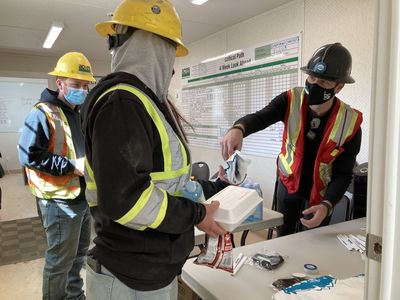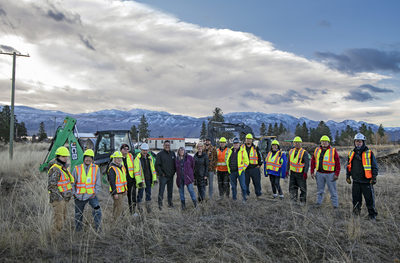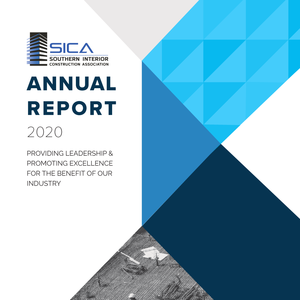
SICA training courses prove practical and meaningful to students
 It’s no exaggeration to say the global economy has been paralyzed by the pandemic. Fortunately for many Canadians, the construction industry was one of the few beacons in an otherwise slow economy greatly inhibited by COVID-19. Of course, the many forms of construction activity couldn’t forge ahead frivolously – social distancing, rigorous cleaning protocols and an abundance of caution were the norm on work sites everywhere, and it’s clear these methods will continue in the months ahead.
It’s no exaggeration to say the global economy has been paralyzed by the pandemic. Fortunately for many Canadians, the construction industry was one of the few beacons in an otherwise slow economy greatly inhibited by COVID-19. Of course, the many forms of construction activity couldn’t forge ahead frivolously – social distancing, rigorous cleaning protocols and an abundance of caution were the norm on work sites everywhere, and it’s clear these methods will continue in the months ahead.
It is because of these prevailing opportunities in southern B.C. that SICA’s Education Department focused some of its efforts on providing meaningful training for the construction industry. One of their great successes in late 2020 was the delivery of a four-week Industry Training Authority (ITA) Road Builders and Heavy Construction foundation program, followed by a two-week intro to Heavy Equipment, catering to Indigenous participants in Westbank, B.C.
The program began in mid-October 2020, combining classroom theory with hands-on equipment experience. The course itself was an example of how clear objectives can pave the way for a well-organized group effort. “Although SICA was responsible for the overall delivery of the program, my colleagues and I coordinated it in collaboration with Westbank First Nation and Okanagan Training and Development Council (OTDC),” SICA Education Services Coordinator Leanna Hendrickson explains. “Over the years, our department has established good working relationships with many of the bands in the southern interior. This wasn’t the first time we’ve assisted with training opportunities and it certainly won’t be the last.”
The Road Builders program was originally slated for March 2020, but the rapid spread of COVID-19 forced a delay. “Even though the program was resurrected in the fall, there’s no question that the training was more difficult because of the pandemic,” says Hendrickson. “We had to have a strict health and safety plan in place – the safety of students and instructors was paramount. But everyone involved was on board and understood the importance of safety protocols from the get-go. After all, the program itself was about teaching safe work practices in road construction and heavy equipment.”
Herb Blamire, an instructor for the program, says, “We created a classroom in a space that belonged to a Westbank band member. The hands-on portion was held on Westbank land further afield, and we brought in a site trailer for that component. [CM-S1] We ended up with 10 students who fully took part, and all 10 graduated.”
Blamire has been involved with heavy equipment construction for most of his life, with 25 years devoted to training people in all aspects. “Our primary focus with this program was to provide the basics, so there was an emphasis on safety,” he says. “The origin of the Road Builders component was developed by ITA, and it represents the first steps for anyone who works in civil construction. The course also introduces students to some of the jargon and terminology common to the trade and sector.”
The first four weeks of the Road Builders program was strictly theory, mainly taking place in the classroom, with some outside work focused on first aid training, traffic control and flagging. Inside the classroom, many of the topics included lessons on land surveying, land-clearing methods and even some of the political and regulatory aspects involved in developing a property for subdivision or road building.
The subsequent two-week Heavy Equipment program was evenly split between the field and classroom. “I looked after the classroom and we brought in Robert Ryl, a certified Heavy Equipment Operator, to look after the hands-on equipment training,” Blamire explains. “We divided the 10 students into two groups of five, so one group would be in the classroom at 7 a.m. and the other would be in the field. In the classroom, students learned theory relevant to specific equipment – not just basic theory but specific to excavators, wheel loaders and compactors, for example. At noon we’d swap the groups, so that each got four hours of field time and four hours of theory.”
During the program, students were required to complete a quiz almost every day, ensuring no one was missing or skipping over the building blocks. In the Heavy Equipment section, there was an exam for each specific piece of equipment.
“Overall, the students did very well on the tests and exams,” says Blamire. “We had a very strong sample here – some averaged over 90 per cent and no one averaged less than 80 per cent. Remember that many of these students, who range in age from their early 20s to one who was 55, may struggle with essential skills such as literacy and numeracy. Which is why classroom support people are invaluable to mentor and assist the students. OTDC provided a program assistant who not only helped with classroom support but coordinated meals and transportation.”
“We all know you can’t take anyone to full efficiency and job preparedness in just six weeks,” Blamire adds. “But I’m pleased to report that a few of our grads did find employment afterwards. My working theory for construction is that you always have to start somewhere, and it’s usually at the bottom – your first machine may well be a shovel!”
“In getting to know the students, it became clear that many were looking for new opportunities,” Hendrickson says. “It was very important for the students to be successful in this endeavor, so we adapted our teaching methods to meet their learning needs.”
“It’s important to not only understand but appreciate the cultural differences in the Indigenous way of life,” Hendrickson concludes. “I think the spirit of cooperation among everyone was there at the very beginning for this program, and it really showed. I also think our success here has revealed a template for future deliveries. We were all delighted with the outcome – and so were the students.
Written by: James Peters for the 2021 Spring Construction Review Magazine
Photo credit: Kelly Funk Photography


Young Bowlers Lawn Bowling Wrap-Up
.png)
BC Government Releases Standardized Housing Designs

BCCA Industry Alert

WorkSafeBC Press Release

SICA Golf Tournament June 7th 2024

Unlocking Efficiency and Innovation: The Power of Building Information Modelling (BIM)

SICA Contractor's Breakfast 2024

BC Budget 2024

Revolutionizing Canada's Construction Industry: The Federal Prompt Payment Legislation

Young Builders Launch Party Wrap Up

CCO Workshop 2024

Membership Appreciation Evening Wrap Up 2023

CCA Hill Day 2023

EBT Flu Clinic Dates

SICA Golf Tournament September 2023

Long Term Members 2022/2023
.png)
Trap & Skeet 2023 Wrap-up

SICA Golf Tournament June 23rd 2023

Industry Awards of Excellence

BC Land Title & Survey Online Filing Process


Join the Virtual Webinar
.png)
The SICA September Golf Tournament was a hit!


Farewell to our Education Admin and Hello to our new SICA staff 2022

CCO Workshop 2022
.png)
MOTI and Infrastructure BC Seeking Interest From Qualified Firms For BC Highway Reinstatement Program RFQ
Prompt Payment Included in ‘Report on the Budget 2022 Consultation’

Regional Construction Associations Partner with BCCA Employee Benefit Trust to Provide Flu Shots for Industry

B.C. associations call on province to practice fair, transparent procurement

SICA announces 2020/2021 Industry Awards of Excellence Finalists

2021 Annual Report

Kelowna Crane Incident Legacy Education Fund

#Hangahighvisoutside

Brooklyn Site Crane Accident Statement

Construction Fast Lanes for COVID-19 Vaccine

Every Child Matters - Indigenous History Month
.jpeg)
Latest Construction Industry Statistics Reveal Strength Despite Pandemic Challenges
.jpeg)
BCCA Response to BC Budget 2021
.png)
CCA Responds to 2021 Federal Budget

Construction Month 2021

BuildForce Canada releases annual 10-year forecast

SICA training courses prove practical and meaningful to students

2021 Gold Seal Program Changes

Building Forward: Virtual Conference 2021

Nomination Period Opens for SICA’s Industry Awards of Excellence

Meet SICA's 2020 New Board Members

SICA's 2020 Annual Report
Membership Benefits
As a Member you are a part of a collective voice, the SICA voice. Together, our voice is changing the construction community and helping your business grow through advocacy, networking events, affinity programs, direct business leads and more. Our voices promotes fairness, transparency and open communication in the construction industry. Join SICA to grow your business today and be a voice for our industry tomorrow.
JOIN NOW